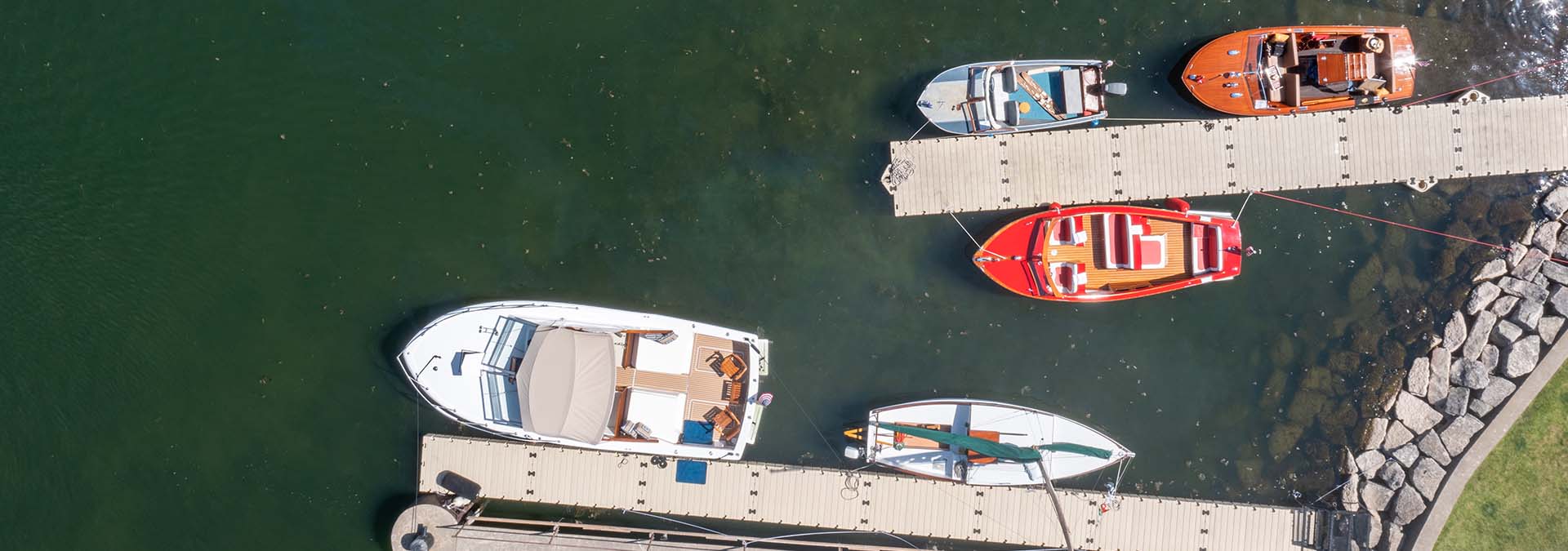
Common Fish of Door County and When to Catch 'em
The Fish of Door County
Door County beckons fishing enthusiasts with its abundant waters teeming with diverse fish species. From serene inland lakes to the vast expanse of Lake Michigan, Door County casts its spell on anglers, promising a remarkable adventure filled with memorable catches and unparalleled serenity.
All you need for a successful excursion is to uncover the secrets of this region's prime fishing spots, learn about the abundant fish species that call these waters home and unveil the prime time to cast your reel and snag your prize. This Door County fishing calendar shares when fish are biting and what you'll catch around the peninsula
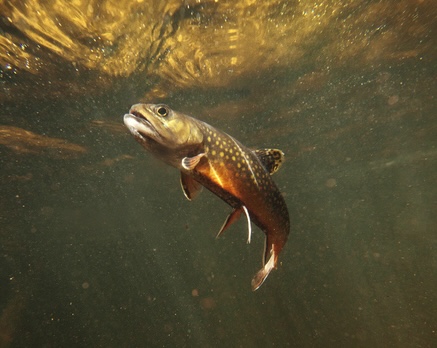
Brook Trout
Where: Baileys Harbor & Ephraim
About: The brook trout is a highly sought-after and instantly recognizable fish, renowned for its mesmerizing combination of vibrant colors and feisty nature. This trout's body is streamlined and elongated, typically six to 16 inches long, although some can grow even larger. The brook trout displays a dark olive-green hue, seamlessly blending into a mottled pattern of lighter shades, creating a natural camouflage that helps it blend into its surroundings. This intricate pattern of spots and vermiculations, ranging from yellow to red, covers the entire body, providing the brook trout with exceptional visual appeal. What truly sets the brook trout apart is its vibrant and fiery belly. In stark contrast to its back, the lower portion showcases a vivid display of oranges, reds and pinks. These colors intensify during the spawning season, when the male brook trout's belly takes on a brilliant, almost fluorescent, orange-red shade, making it an unforgettable sight.
How to Catch a Brook Trout in Door County: How to Catch Brook Trout in Door County Brook trout are most active during the twilight hours of dawn and dusk, although they may seek deeper waters during the daytime. Anglers often use mayflies, stoneflies and caddisflies to imitate the insects they feed on. For those fishing with flies, streamers and nymphs fished along the stream bottom can attract larger brook trout. It's crucial to assess the river and identify prime spots that provide the three essential elements for brook trout: cool and clean water, an ample food supply of insects, crawfish, and minnows, as well as natural cover from predators.
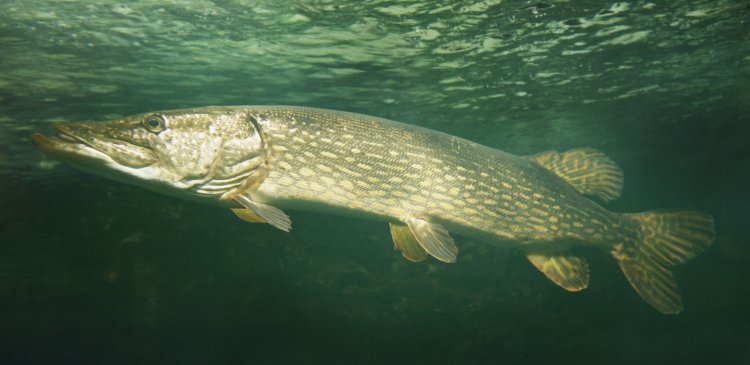
Northern Pike
Where: Bay Side and Detroit Harbor
About: The northern pike is renowned for its impressive size, strength and aggressive nature, making it a prized catch for anglers seeking thrilling encounters on the water. Its long, cylindrical body is well-suited for rapid and powerful movements through the water. Adult northern pike can grow to impressive lengths, often exceeding three feet and weighing several pounds. In some exceptional cases, these apex predators can reach over four feet and weigh more than 50 pounds.The coloration of a northern pike can vary, but it typically features a combination of green, yellow and light brown hues on its back, transitioning to a lighter shade along its sides and belly. This coloring helps it blend seamlessly into its aquatic environment, making it a stealthy predator. One of the most distinctive features of the northern pike is its elongated and narrow snout.
How to Catch Northern Pike in Door County: When targeting northern pike, various bait options can effectively entice these formidable predators. Using live bait can be highly successful in attracting northern pike. Large minnows are often favored as they mimic the natural prey of pike. Make sure to rig them on a sturdy wire leader to prevent bite-offs. Success can also be had with flashy, lifelike lures. Large spoons, crankbaits, swimbaits and spinnerbaits are all also productive options. Opt for those with bright colors, realistic swimming actions and a bit of flash to grab the pike's attention.
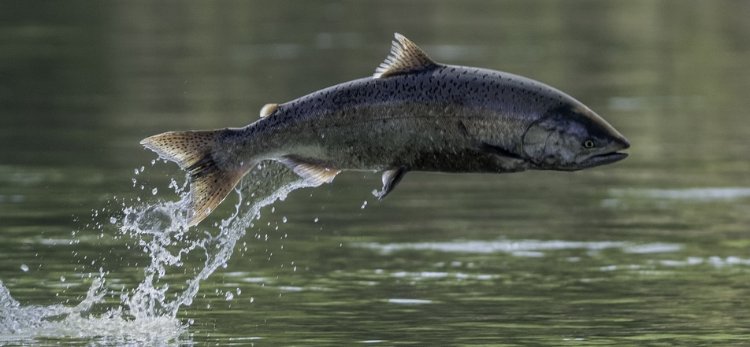
Chinook Salmon
Where: Lakeside and bayside
About: Chinook salmon are the largest species of Pacific salmon, renowned for their impressive size and strength. They have a streamlined body shape that is well-suited for their migratory lifestyle. On average, adult Chinook salmon measure between 24 and 36 inches in length and weigh anywhere from 20 to 50 pounds (with some reaching incredible lengths exceeding four feet and weighing over 100 pounds). The coloration of Chinook salmon can vary depending on their life stage and habitat. When they are in freshwater environments, such as during spawning, their appearance changes significantly. Mature, spawning Chinook salmon develop vibrant colors and unique physical characteristics. Their back and upper body typically showcase a dark blue or greenish hue, transitioning to silver along the sides and belly. This striking contrast helps them camouflage in different water conditions. As the salmon matures, its mouth becomes elongated and hooked. During the spawning season, mature male Chinook salmon develop a pronounced hump on their back, which gives them their nickname "humpies." They also exhibit a color change, with vibrant red and green hues adorning their body and dark vertical bars known as "parr marks." The female Chinook salmon, or hens, also undergo color changes, displaying a similar vibrant combination of red, green and dark spots.
How to Catch Chinook Salmon in Door County When targeting Chinook salmon in Door County's waters, anglers often use a combination of live bait, artificial lures and various attractants. A popular live bait option is alewives, which are natural prey fish for Chinook salmon. Other live bait options include smelt, shiners or large minnows. Spawn sacs, also known as salmon eggs, with a scent and texture that attracts the salmon. A common method here is trolling with plugs. Large diving plugs mimic the appearance and action of baitfish and can be cast or trolled behind a boat to cover a larger area. Other options include flashers and spoons. Whatever you choose, it's essential to consider factors such as water temperature, depth and current conditions when selecting bait for Chinook salmon.
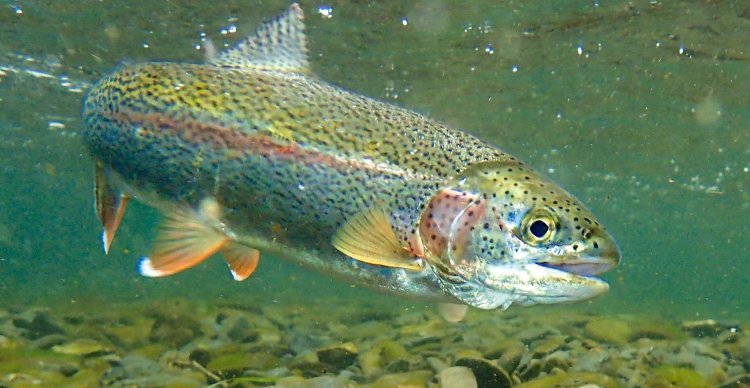
Rainbow Trout
Where: Lake Michigan Shore
About: The rainbow trout is a beautiful and highly sought-after freshwater fish species. On average, rainbow trout measure between 12 and 20 inches in length, although they can grow larger depending on environmental conditions and available food sources. The coloration of rainbow trout is one of their most distinguishing features. Their back and upper body typically exhibit a dark olive-green hue, gradually transitioning to a silvery color along the sides and belly. The sides of a rainbow trout are often adorned with a series of distinctive black spots, known as "parr marks," that resemble a chain or worm-like pattern. These spots become more pronounced towards the tail region. Another striking characteristic of the rainbow trout is its vibrant lateral stripe, often called the "rainbow." This stripe runs along the lateral line of the fish, extending from the gills to the tail. The coloration of the rainbow stripe can vary, ranging from a pale pink or red hue to a brilliant, iridescent silver or even gold, particularly in spawning males. This fish showcases a remarkable combination of colors, making it visually striking and appealing to anglers.
How to Catch Rainbow Trout in Door County Rainbow trout are commonly found in rivers, streams and inland lakes. These fish are known to be aggressive and will often strike at various artificial lures. Small spinners, spoons and inline spinners in colors like silver, gold or bright and vibrant patterns can attract their attention. Additionally, small crankbaits, soft plastic swimbaits and jerkbaits can be effective when mimicking small baitfish.
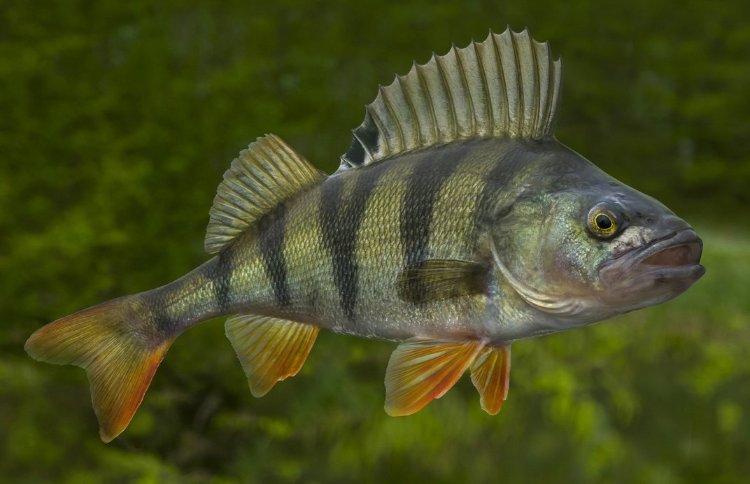
Perch
Where: Inland Lakes, Bay Side & Lake Side
About: Perch have a relatively elongated and laterally compressed body shape and have a rounded and slightly tapering profile. The perch size can vary depending on the species and habitat, ranging from a few inches to over a foot in length. The coloration of perch varies, but they often exhibit a combination of green, yellow or brown hues on their upper body. The sides of the fish tend to be lighter in color, transitioning to a silver or white belly. Some species have distinctive vertical stripes or bars along their sides, which can be dark or faint depending on the individual fish. Their eyes are relatively large and positioned high on the head.
How to Catch Perch in Door County Perch are known to be opportunistic feeders and readily take live bait. Minnows, particularly small fathead minnows or shiners, are commonly used to entice perch. Hook them through the back or lips to allow for natural swimming action. Other live bait options include worms, waxworms or small nightcrawlers. Other bait options include soft plastic baits, such as small grubs, twister tails or tube baits and small jigs with brightly colored bodies, ranging from 1/16 to 1/8 ounce in weight.
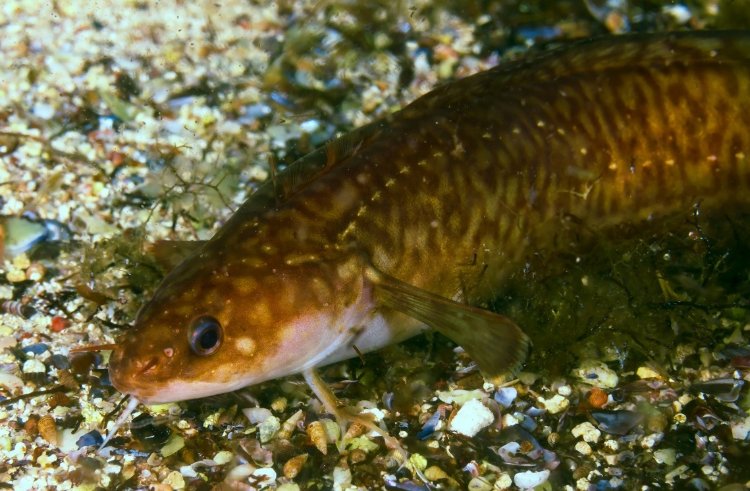
Burbot (aka Lawyer Fish)
Where: Northern Door & Washington Island
About: The burbot, also known as the lawyer fish, has a long, slender body that is cylindrical. It typically measures between 18 and 35 inches in length and weighs anywhere from a few pounds up to 20 pounds or more. Its back and upper body are usually dark brown, olive or mottled with shades of green to help it blend into its surroundings. The sides of the fish are lighter in color, ranging from yellowish to light brown or even pale gray. The belly is typically white or pale yellow. The overall coloration can vary depending on the habitat and age of the fish. One distinctive feature of the burbot is its whisker-like barbels, which are found near its mouth. These sensory organs help the fish detect prey in dark or murky environments. Its shape is somewhat eel-like, with a slightly flattened head.
How to Catch Burbot in Door County Burbot are known to be opportunistic feeders and are attracted to strong-smelling baits. Cut bait, such as chunks of fish, can be highly effective. Common choices include pieces of smelt, sucker or other oily fish. Place the cut bait on a sturdy hook, ensuring it is adequately secured to withstand the burbot's strong bite. Small fish, such as smelt, shiners or chubs, can also be used as live bait. Rig them on a hook using a Carolina rig, slip bobber setup or bottom rig, allowing them to swim freely to attract burbot. Popular artificial baits include Gulp! Alive! Nightcrawlers and creature baits, such as crayfish imitations.
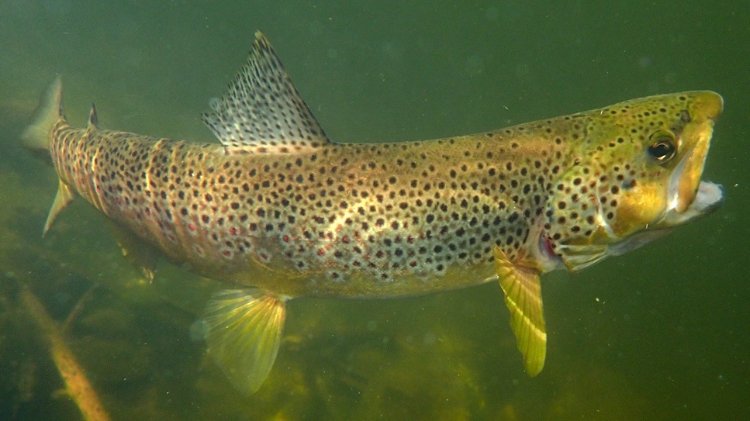
Brown Trout
Where: Lakeside & Green Bay Shoreline
About: Brown trout have a streamlined and elongated body shape, typical of most trout species. It can vary in size, ranging from a few inches to over 30 inches in length. Brown trout exhibit sexual dimorphism, with males usually growing larger and developing more prominent physical characteristics during the spawning season. One of its most distinctive traits is their coloring. The back and upper body generally display shades of olive-brown, dark brown or bronze that blend into a light golden or yellowish-brown along the sides, eventually transitioning to a creamy or white underbelly. Parr marks often cover the fish, which vary in intensity and fade as the fish ages. In addition to the parr marks, the sides and back of a brown trout are adorned with numerous red, orange or yellow spots, which can range in size and intensity. These spots may become more pronounced and vibrant in mature males during spawning. The beautiful and intricate color pattern provides effective camouflage in its freshwater habitats.
How to Catch Brown Trout in Door County Brown trout are known to be opportunistic feeders and are attracted to live bait. Small minnows, such as fathead minnows or shiners, can be highly effective when rigged on a hook with a split shot or using a small bait rig. Another effective live bait option is nightcrawlers, which can be presented on a hook or threaded onto a spinner rig. Artificial lures are also effective. During the spawning season, brown trout feed on fish eggs, so using spawn sacs or egg patterns can effectively entice these fish. They can also be caught using natural baits such as worms, maggots or waxworms. Rig them on a hook and present them naturally, allowing them to drift with the current or using a slow retrieve.
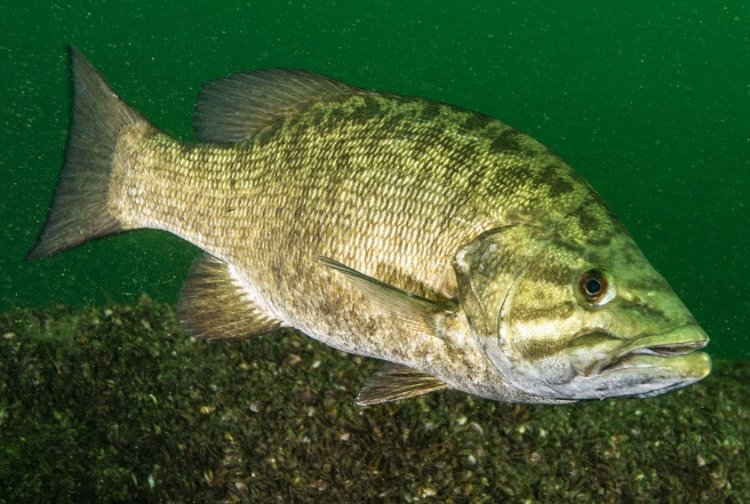
Smallmouth Bass
Where: Sturgeon Bay & Washington Island
About: The smallmouth bass has a robust and muscular body with a streamlined shape, which enables it to navigate swiftly through the water. On average, it measures between 12 and 20 inches in length and can reach up to 24 inches or more. Smallmouth bass are known for their fighting ability, making them a favorite among anglers. The coloration of a smallmouth bass varies depending on its habitat and environmental factors. Typically, its back and upper body are olive to brown in color, which helps it blend with its surroundings. The sides of the fish transition to a lighter bronze or golden color, often with a mottled pattern of vertical bars or blotches. These bars can be irregular and vary in intensity. The belly of the smallmouth bass is usually white or cream-colored. Of course, one of the most distinctive features of the smallmouth bass is its large mouth, which extends back to the middle of its eye. It has a lower jaw that protrudes slightly beyond the upper jaw.
How to Catch Smallmouth Bass in Door County Live bait, such as fathead minnows or shiners and nightcrawlers and leeches, are commonly used to catch smallmouth bass. Soft plastic baits, such as tubes, creature baits, worms and grubs, are highly effective for catching smallmouth bass. Crankbaits are versatile lures that imitate baitfish; opt for medium-sized crankbaits that dive to the desired depth range. Spinnerbaits and topwater lures can elicit exciting strikes from smallmouth bass, particularly during low-light conditions or when fish feed near the surface.
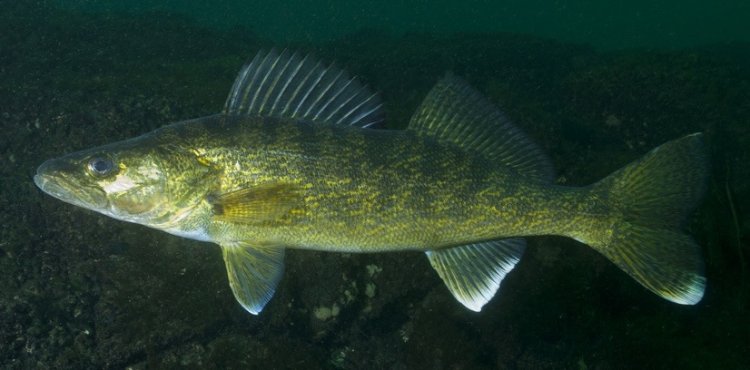
Walleye
Where: Bay Side & Inland Lakes
About: The walleye has a relatively sleek and elongated body, typically ranging from 14 to 30 inches, with some exceeding 30 inches. Walleye exhibit sexual dimorphism, with females generally growing larger than males. The coloration of a walleye is one of its most distinctive features. Its back is olive to dark brown, gradually transitioning to a golden or yellowish hue along its sides. The belly is usually white or cream-colored. Walleye have a unique feature known as the "walleye" or "glass eye," after which they are named. This feature is a reflective layer that gives their eyes a glassy appearance and enables them to see exceptionally well in the dark. Their lower jaw extends slightly beyond the upper jaw, giving them a protruding appearance.
How to Catch Walleye in Door County One of the most effective and versatile bait options for walleye is a live minnow, such as a fathead minnow, shiner or sucker minnow, rigged on a jighead. Nightcrawlers are widely used rigged on a hook with a slip sinker or a crawler harness with multiple hooks, cast near the bottom or along drop-offs. Leeches, artificial leadhead jigs and crankbaits, as well as spinner rigs slowly trolled or drifted near rocky areas, drop-offs or weed edges also work well.
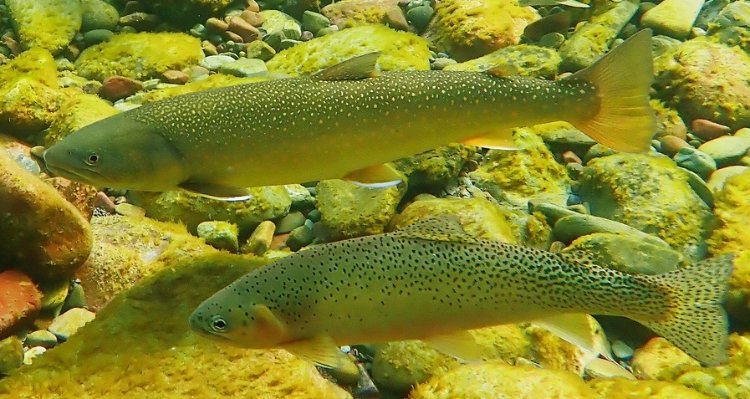
Whitefish
Where: Bay Side
About: The whitefish has a relatively streamlined body with an elongated shape. It typically measures between 12 and 24 inches in length, although some species can grow even larger. Whitefish have a slender, torpedo-like body, which allows them to move swiftly through the water. The coloration of a whitefish varies depending on the species and habitat. Generally, their back and upper body are olive-green to brown, blending with the surrounding environment. The sides of the fish transition to a lighter silver or white hue, where the common name "whitefish" originates. The belly of the whitefish is usually white or cream-colored. It is covered in large, smooth scales with a distinctive shimmer that gives the fish a silvery appearance when they reflect light.
How to Catch Whitefish in Door County Whitefish have a strong affinity for eggs, and using spawn sacs is a common and effective technique. Spawn sacs are small bags of mesh or fabric containing fish eggs, typically from salmon or trout. These sacs are threaded onto a hook and presented near the bottom, often in conjunction with a sinker or a jig. Waxworms and maggots are commonly used live baits for whitefish. These small, wriggling larvae are available at bait shops and are often presented on a small hook or threaded onto a jig. They can be particularly effective during the colder months when whitefish are feeding near the bottom.

Safety First
No matter what you're fishing for in Door County and beyond, it's important to consider the specific fishing regulations and restrictions in the lake or waterway you're fishing in, as they may impose specific rules regarding live bait usage and fishing techniques.
Additionally, observing local fishing reports, consulting with experienced anglers and experimenting with different bait options can help determine what works best for what you're trying to catch.

